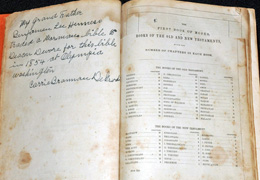On October 17, 1855, after hearing news of Indian uprisings in other parts of Washington Territory, residents of Skookumchuck (later Centralia) begin construction on Fort Henness. The fort on what is now Grand Mound Prairie is 100 by 130 feet and surrounded by a log palisade. On October 31st, having received warning of an imminent attack, 23 families take cover in the half-completed fort. Neither that attack nor any other ever materializes, but the families remain at the fort throughout the hostilities, some for as long as 16 months.
The fort, when completed, had two bastions at opposite corners and gates at the end, with a well dug within the wall. The residents set up temporary shelters and settled in. The men in the group formed Company F the First Regiment of Washington Territorial Volunteers and elected Benjamin Lee Henness as their captain. The company primarily transported supplies to other troops to the north.
Not everyone in the area moved into the fort. George and Mary Waunch stayed on their farm, as did George Washington, who had built his own stockade. Patterson Luarck stayed at home and wrote in his diary, "I for one thought the building of a fort not only unnecessary but injurious to our friendship with our neighboring Chehalis Indians. Therefore I did not help built the fort" (Smith, 165).
Sidney and Nancy Ford also stayed at their home, having built their own defenses. Sidney Ford, the local Indian agent, worked out an agreement with the Upper Chehalis who lived in the area for them to move onto his land and surrender their weapons. Some of the tribe helped with patrolling the area.
The Upper Chehalis did not participate in the uprising even though they had not yet ceded the land on which local settlers filed claims. The Chehalis refused to sign the treaty Territorial Governor Isaac Stevens offered the Chehalis and other tribes at the Chehalis River Treaty Council of February 1855. They did not oppose ceding their land, but instead rejected the reservation terms proposed.
In the spring of 1857 the fort disbanded. There had been no deaths and no property damage in the area. The most lasting impact of the fort lay in the social life it offered to otherwise isolated American settlers whose homesteads lay scattered around the valley.

